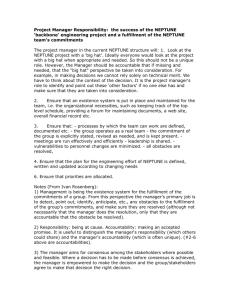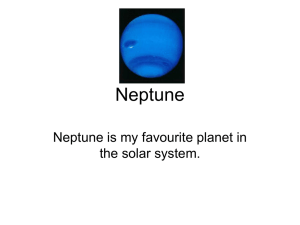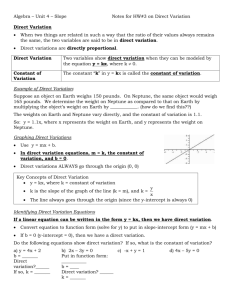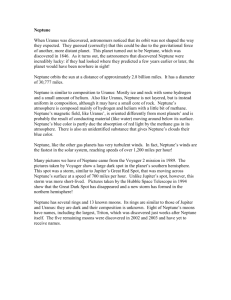Neptune
advertisement
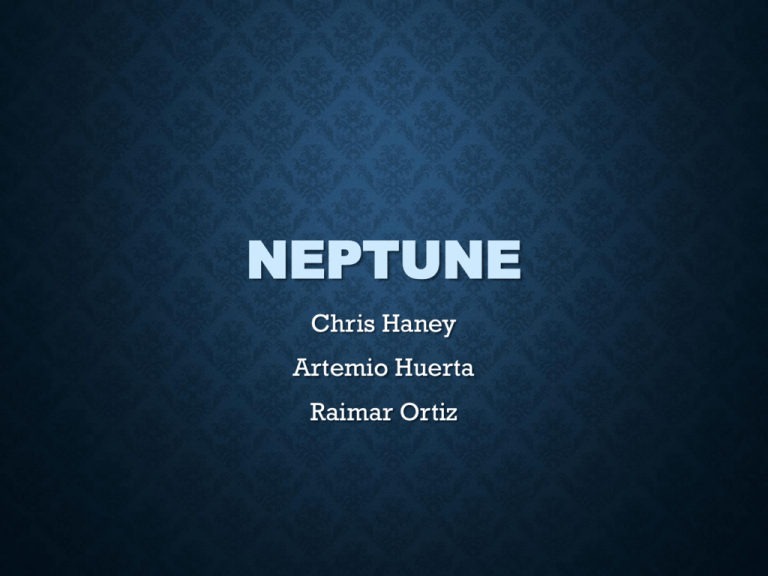
NEPTUNE Chris Haney Artemio Huerta Raimar Ortiz DATE OF DISCOVERY • Neptune was discovered on September 23rd 1846, by Urbain Le Varrier and Johann Galle. SIZE OF NEPTUNE • Neptune is the eighth and farthest planet from the Sun in the Solar System. It is the fourth-largest planet by diameter and the thirdlargest by mass. Among the gaseous planets in the Solar System, Neptune is the most dense. • Distance from Sun: 2,798,000,000 miles (4,503,000,000 km) • Mass: 102.4E24 kg (17.15 Earth mass) • Orbital period: 165 years • Length of day: 0d 16h 6m • Gravity: 11.15 m/s² NAME • Neptune was named after The Roman God of the sea. FACTS ABOUT NEPTUNE • Neptune is the smallest of the ice giants: Despite being smaller than Uranus, Neptune has a greater mass. Below its heavy atmosphere, Uranus is made of layers of hydrogen, helium, and methane gases. They enclose a layer of water, ammonia and methane ice. The inner core of the planet is made of rock. FACTS ABOUT NEPTUNE • The atmosphere of Neptune is made of hydrogen and helium, with some methane: The methane absorbs red light, which makes the planet appear a lovely blue. High, thin clouds drift in the upper atmosphere. • Neptune has a very active climate: Large storms whirl through its upper atmosphere, and high-speed winds track around the planet at up 600 meters per second. One of the largest storms ever seen was recorded in 1989. It was called the Great Dark Spot. It lasted about five years. THE GREAT DARK SPOT • Pictures taken By the Hubble telescope • The Great Dark Spot was a huge spinning storm in the southern atmosphere of Neptune which was about the size of the entire Earth. Winds in this storm were measured at speeds of up to 1,500 miles per hour. These were the strongest winds ever recorded on any planet in the solar system! The Great Dark Spot was first discovered when the Voyager 2 spacecraft flew by Neptune in 1989. When the Hubble Space Telescope looked THE RINGS OF NEPTUNE • Neptune's unusual rings are not uniform, but possess bright thick clumps of dust called arcs. The rings are thought to be relatively young and short-lived. Earth-based observations announced in 2005 found that Neptune's rings are apparently far more unstable than previously thought, with some dwindling away rapidly, according to an article in the journal Icarus. FORMATION OF NEPTUNE • Neptune is generally thought to have formed with the initial buildup of a solid core followed by the capture of surrounding hydrogen and helium gas in the nebula surrounding the early sun. In this model, proto-Neptune formed over the course of 1 to 10 million years. NEPTUNE'S MOONS • Neptune has 14 known moons, named after lesser sea gods and nymphs from Greek mythology. The largest by far is Triton, whose discovery on Oct. 10, 1846, was in a sense enabled by beer — amateur astronomer William Lassell used the fortune he made as a brewer to finance his telescopes. • Triton is the only spherical moon of Neptune — the planet's other 13 moons are irregularly shaped. It is also unique in being the only large moon in the solar system to circle its planet in a direction opposite to its planet's rotation — this "retrograde orbit" suggests that Triton may once have been a dwarf planet that Neptune captured rather than forming in place, according to NASA. Neptune's gravity is dragging Triton closer to the planet, meaning that millions of years from now, Triton will come close enough for gravitational forces to rip it apart. VIDEOS ABOUT NEPTUNE • https://www.youtube.com/watch?v=76xz74X4ivw • https://www.youtube.com/watch?v=EmUvTH7sveg • https://www.youtube.com/watch?v=keNiv-T6WT4
